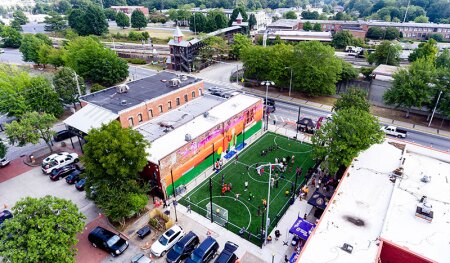After another exciting FIFA World Cup, many people in Atlanta will be keeping a close eye on the festivities when the tournament comes to North America in 2026. Atlanta is one of 16 cities hosting matches. Sanjay Patel, an Atlanta resident who will be part of the city’s planning efforts, has an especially keen interest as the director of strategic projects at Soccer in the Streets, a local nonprofit organization.
Patel, originally from England, began volunteering with the organization about 12 years ago. A year later, he became a board member of the nonprofit organization that was founded more than 30 years ago by Georgia resident Carolyn McKenzie. Soon after Patel joined the board, he began to observe that the organization often had to spend money on costs related to transportation.
“At the time, I was using the MARTA [Metropolitan Atlanta Regional Transit Authority] train system here in Atlanta to get into downtown and realized that there were spaces in and around train stations that were unused,” says Patel, who has a background as a real estate developer. “That’s how the StationSoccer idea came about of what if we took these spaces and actually utilized them to build safe spaces to play and beat the transportation hurdle by using the transit system and connecting communities that way.”
The organization then worked with city officials on the permitting process and installed the first StationSoccer location at Atlanta’s Five Points Station. That was six years ago.
“We learned that was the first soccer field inside a train station in the world,” Patel says.
The idea took off, and soon other locations followed. The sites now also include Kensington, West End, East Point, and Lindbergh.
In addition to MARTA, it also wasn’t long before the city of Atlanta came on board. The desire of city officials to help grew after working with Patel on the initial Five Points location, according to Tim Keane, who was commissioner of city planning at the city of Atlanta at the time.
“Once we went through that process with them and that station was installed, our interest in helping them grew substantially because of the uniqueness of what Soccer in the Streets was doing at these MARTA stations,” Keane says.
The city of Atlanta ended up becoming a financial partner as well. City officials initially requested backing from the Atlanta City Council in the amount of $600,000, according to Keane.
Each soccer site is free for all the children who participate. Keane says it was a no brainer to get involved since it is such a unique program.
“Yes, soccer is at the center of it, but it’s really community development in its purest form,” Keane says. “In the sense that trying to help the communities, the families, the children that otherwise wouldn’t have access to such things, including soccer, but all the things that they do to help the kids and the families of those kids progress in life.”
Partnering in the Community
Other partners have also been brought in to assist with the program, including the professional soccer team, Atlanta United, as well as global architectural firm HKS. The program’s goal is to create a “A League of Stations.” Sheba Ross, global practice director of cities and communities and associate principal and senior vice president in the Atlanta office of HKS, says that instead of ad hoc ideas, StationSoccer aimed to “get a design firm to cast a cohesive vision,” Ross says.
HKS performed an analysis of each of the StationSoccer locations. The firm then identified where the communities where they were located had gaps. One area had a lack of access to healthy food and another was experiencing higher unemployment, for example, according to Ross.
“All these 10 communities are completely different from each other, and even if soccer is a common denominator, what else can design do?” says Ross of their approach.
The goal was not to have just a blanket idea across the 10 stations, according to Ross. Community gardens were created at the Kensington and West End locations. Also at the Kensington Station, which has a large immigrant population, an area artist was recruited who was able to “represent this mosaic of cultures,” Ross says.
“It was really neat to see these kinds of, as we call them, social infrastructure activities, take place,” Debbie B. Frank, director of Transit-Oriented Development at MARTA, says. “Just other things that people can get engaged in other than just moving through the station from one location to the next. There are reasons for people to stop and hang out, reasons for people to garden.”
HKS employees have even served as volunteers. MARTA is also planning to donate decommissioned rail cars to StationSoccer which HKS plans to incorporate into their designs. Future learning centers at the sites are also in the works.
Making an Impact
StationSoccer now impacts about 1,000 children in Metro Atlanta with approximately 200 participating at each of the five sites that are currently operating, according to Patel.
He says it has also been rewarding to see local families who previously had no access to land near the stations, since it was fenced off when the railroad tracks were built, now flocking to the open spaces to watch their children play. Patel describes it as a “great win-win for everyone.”
Secretary of Transportation Pete Buttigieg also visited StationSoccer’s East Point location last year. Patel says Buttigieg was interested in seeing transit-oriented projects and finding out how various partnerships in neighborhoods can be formed to fuel their success.
The work of StationSoccer has garnered numerous awards, and HKS even received an AIA design award for its work. However, from Patel’s point of view, there is nothing more rewarding than seeing the fruit of their labor with the goal of operating 10 locations by the 2026 World Cup.
“It just goes to show that when you get people collaborating, what can be done,” Patel says. “It’s nice to get the awards, but really it goes down to when folks get access to these spaces, and what can be done [is] some really impactful work within communities that can help change and bring healthy, active lifestyles and safe spaces to communities that normally wouldn’t have access to things like that.”








